Housing Prices: More Room to Fall?
Finance & Development, March 2010, Volume 47, Number 1
From a historical perspective, it is not the trend but the volatility in housing prices that is distinctive
IN 1625, Pieter Fransz built a house in Amsterdam’s new Herengracht neighborhood. As the Dutch Republic rose to global power in the 1620s—with Amsterdam developing the world’s first major stock market as well as commodities and futures markets—the price of the house doubled in less than a decade. Over the succeeding three centuries, the price of Fransz’s house was knocked down by wars, recessions, and financial crises and rose again in their aftermaths (Shorto, 2006). When the house changed hands in the 1980s, its real value, that is after inflation, had only doubled over the course of 350 years––offering a very modest rate of return on the investment.

Indeed, viewed over the long course of history, the distinctive feature of house prices in Herengracht has been not the trend but the cycles (see Chart 1): innovations and good times raised the price for years at a time and—seemingly just when the conviction had taken root that this time would be different—shocks came along to knock prices back down.
Starting in the late 1990s, prices of houses in Herengracht, and more generally in Amsterdam, 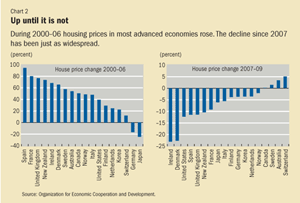 doubled in value in 10 years, only to begin another sharp decline. This recent run-up and correction in prices in Amsterdam was part of a global boom and bust in house prices. House prices soared in the United States, fueled by innovations in housing finance. They also rose in Ireland, coinciding with a historic growth surge; in Spain and Australia, buoyed by immigration; and in Iceland as part of a boom induced by a tremendous expansion in the country’s financial sector. In 2006, house prices started to fall, first in the United States and then elsewhere (see Chart 2).
doubled in value in 10 years, only to begin another sharp decline. This recent run-up and correction in prices in Amsterdam was part of a global boom and bust in house prices. House prices soared in the United States, fueled by innovations in housing finance. They also rose in Ireland, coinciding with a historic growth surge; in Spain and Australia, buoyed by immigration; and in Iceland as part of a boom induced by a tremendous expansion in the country’s financial sector. In 2006, house prices started to fall, first in the United States and then elsewhere (see Chart 2).
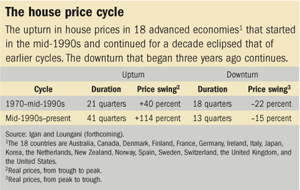
This boom-bust cycle is commonly seen as a major contributor to the global financial crisis, itself generally recognized as the most dangerous economic threat the world has faced since the Great Depression. Understanding the causes of house price cycles and how to moderate them is important for the maintenance of macroeconomic stability, both at the national and global levels.
What do we know about the incidence and amplitude (price swings from peak to trough and vice versa) of house price cycles in countries across the globe? What are the driving forces behind these cycles? And what does this analysis tell us about the future of house prices?
Facts about housing cycles
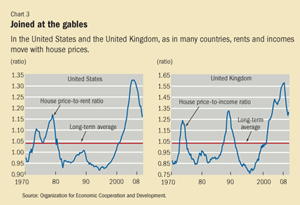
Establishing the turning points in a series of economic data—“dating” cycles—is more reliable the farther back in time the series extends. House price data going back to the 1600s, such as for the Herengracht neighborhood in Amsterdam, are the exception and not the rule. But for many members of the Organization for Economic Cooperation and Development (OECD), national house price data do extend back to 1970, which is long enough to permit reliable dating of house price cycles.
Between 1970 and the mid-1990s, the average upturn in house prices in 18 OECD economies lasted just over five years, during which real (inflation-adjusted) prices increased an average of 40 percent (see table). The subsequent downturn typically lasted four and a half years, and prices fell about half as much as they rose during the upturn.
The past offers a prism through which to view the present house price cycle, which started sometime between the mid-1990s and early 2000s for most countries. The upturn in this most recent cycle lasted twice as long on average as those in the past (41 quarters compared with 21 quarters) and was more pronounced, with prices rising nearly three times as much. The ongoing downturn is approaching the duration of past downturns, and the fall in house prices thus far is nearing the amplitude of past downturns. But because prices rose much more sharply than in earlier upturns, their decline might eclipse those observed in the past.
Driving forces behind house price cycles
Why do house prices go through the cycles shown in the table? Both long-run relationships and short-run forces are at work.
Long-run relationships: Economic theory asserts that house prices, rents, and incomes should move in tandem over the long run. Why? Consider house prices and rents first. Buying and renting are alternate ways of meeting the need for shelter. In the long run, therefore, house prices and rents cannot get out of sync. Were that to happen, people would switch between buying and renting, bringing about adjustments both in prices and rents to bring them back in line. Likewise, in the long run, the price of houses cannot stray too far from people’s ability to afford them––that is, from their income.
Take, for example, these long-run relationships in the United States and the United Kingdom (see Chart 3). The ratio of house prices to rents in the United States reverted to its long-run average four times between 1970 and the early 2000s. House prices increased far more than rents in the 1970s, but between 1980 and 2000 the price-to-rent ratio fell to a little below its long-run average. Between 2000 and 2006, the ratio of house prices to rents rose dramatically above the long-run average and has been moving back toward it since then. Thus by this metric too, as with past cycles’ amplitude, there may be more correction yet to come. In the United Kingdom it is a similar story for the ratio of house prices to income. Between 1970 and 2000, the ratio hovered around its long-run average, albeit with a couple of sharp swings away from it. Since 2006, the ratio has begun descending toward its long-run average, although it still remains well above it.
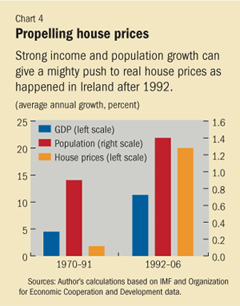
Short-run determinants: Whereas the long-run relationships act as an anchor, in the short run house prices do drift away, often quite strongly and for long periods. Strong demand momentum leads to increases in house prices, and often the increase is more than can be explained fully by the underlying driving forces. Ireland is a good illustration (see Chart 4). During 1992–2006 Ireland enjoyed robust income growth of more than 10 percent a year, more than twice the average of the preceding two decades. Population growth also picked up after 1992. The rise in house prices was more than commensurate with these factors—prices increased nearly 20 percent a year between 1992 and 2006, 10 times the rate of the previous two decades.
One reason house prices go up so rapidly is that the supply of housing cannot be adjusted quickly. Another reason lies in the interaction of housing and financial markets. Because houses serve as collateral, an increase in house prices can have a feedback effect: once collateral values increase, banks are willing to lend even more to households, which feeds the house price boom. This feedback effect can arise regardless of what caused house prices to go up in the first place—demand momentum, government policies such as low interest rates, or institutional changes that increase the availability of mortgage credit.
Moreover, fundamental driving forces do not fully explain all price movements in all countries at all times. As Yale University economist Robert Shiller and others assert, house prices may be determined by psychological and sociological factors; these factors may also amplify the response of house prices to fundamentals (see box).
Housing prices: Fundamentals or bubbles?
Robert Shiller is well known for predicting the U.S. stock market crash of 2000–01 (see F&D, September 2008). In 2003, he warned that U.S. house prices too contained a “bubble”; that is, they had risen far beyond what was warranted by fundamental driving forces such as income growth, interest rates, demographic change, and building costs. Shiller showed that the ratio of house prices to both rents and incomes was the highest it had been in a century.
Shiller thinks that such bubbles form because expectations of asset prices are often formed by stories and social perceptions of reality and by excessive confidence in positive outcomes. Corrupt and antisocial behavior by some can act to magnify the bubble. In the context of U.S. housing markets, Shiller argues, people became attached to the perception that house prices never fall or that this time would be different. The marketing of mortgage loans to people with manifest inability to repay and the repackaging of such loans into marketable securities served to magnify the consequences of these false perceptions.
In contrast, Yeshiva University economist James Kahn, in work done with coauthor Robert Rich at the Federal Reserve Bank of New York, asserts that the surge in U.S. house prices can be explained by economic fundamentals, particularly expectations of income growth. Kahn’s work suggests that the surge in house prices from the mid-1990s to 2007 was based on a belief that productivity growth would lead to continued growth in incomes. The dynamic reversed in 2007 when productivity growth was perceived to have slowed, thereby stifling the housing boom and the viability of mortgages predicated on sustained increases in house prices. Though U.S. productivity growth had begun to decelerate in 2004, the perception of that deceleration caught up with reality only in 2007, according to Kahn.
Kahn also argues that because of the relatively inelastic nature of the housing supply, house prices can grow faster than incomes in periods of above-average economic growth and fall sharply when growth slows. The resulting amplification of price responses to underlying changes in the fundamental determinants manifests itself very much like the bubble-and-bust scenario that recently took place.
More room to fall?
Though there are some signs of stabilization, the global correction in housing markets continued through 2009. House prices in the OECD economies fell on average about 5 percent in real terms between the fourth quarter of 2007 and the third quarter of 2009.
How low can prices go? There are a number of factors to consider.
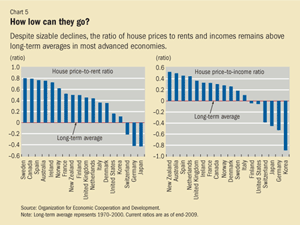
First, house prices in most countries still remain well above the levels observed at the beginning of the upturn in the early 2000s. Second, house prices remain above rents and incomes, which, as discussed above, often serve as long-run anchors for prices. Chart 5 shows how much farther the ratio of house prices to rents and incomes would have to fall in each country to bring it down to its long-run average. Third, econometric models show that house prices increased during 2000–06 to a greater degree than can be explained by either short-run driving forces or long-run relationships: the corrections thus far have not erased all of the excesses generated by the house price increases.
That leads to an uncomfortable conclusion: house prices in many countries still have room to fall.
References:
Igan, Deniz, and Prakash Loungani, forthcoming, “Global Housing Cycles,” IMF Working Paper (Washington: International Monetary Fund).
Shorto, Russell, 2006, “This Very, Very, Old House,” The New York Times Magazine, March 5.


